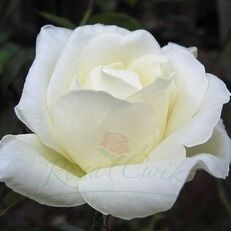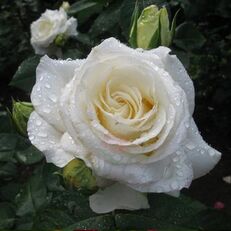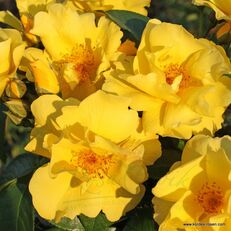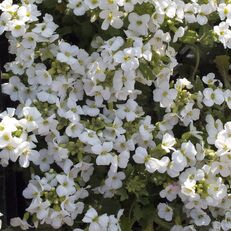Jastruń Wielki Madonna flower seedling
PDF
Share
Facebook
WhatsApp
Viber
Telegram




Interested in the ad?
1/3
PDF
Share
Facebook
WhatsApp
Viber
Telegram
€4.16
PLN 18
≈ $4.39
≈ $4.39
Contact the seller
Type:
flower seedling
Location:
 Poland7172 km from you
Poland7172 km from you
Placed on:
Nov 8, 2024
Seller stock ID:
848
Details:
English
Polish
Automatically translated from Polish
Characteristics of the Plant Great daisy forms compact tufts of semi-evergreen leaves with erect shoots, on which characteristic baskets with yellow centers appear from June to autumn. Removing faded baskets prolongs flowering. Depending on the variety, the perennial reaches a height of 30-90 cm. The inflorescences are large and can reach a diameter of up to 10 cm. The plant is popularly called da...
Characteristics of the Plant
Great daisy forms compact tufts of semi-evergreen leaves with erect shoots, on which characteristic baskets with yellow centers appear from June to autumn. Removing faded baskets prolongs flowering. Depending on the variety, the perennial reaches a height of 30-90 cm. The inflorescences are large and can reach a diameter of up to 10 cm. The plant is popularly called daisy or marguerite. Depending on the variety, the ligulate flowers can be single, semi-double, full, with the characteristic perennial shape of ligulate flowers or with narrow, needle-like or tubular flowers, in white or yellow-white. The perennial is used in flower beds, but is also suitable for meadow lawns in larger gardens. Lower varieties can be planted in rock gardens and in containers. The flowers are suitable for cutting. The largest flowers and their abundance will be provided by a fairly fertile and moderately moist soil and a sunny position. Light, sandy soils should be avoided, as well as heavy, clayey soils, very wet in winter. Plants should be divided and transplanted to a new location every 3 years.
Features of the Plant
Flowering period: VI-VIII, IX
Height with flower: 25
Height without flower: 20
Flower color: white
Leaf color: green
Location: sunny
Water requirements: medium humidity
Soil pH: neutral - pH 6.6 - 7.2
Soil type: average garden
Frost resistance: group 6 -23.3 to -17.8
Number of plants per m²: 9
naturalistic
cut flower
container
discount
on the rockery
flower meadow
Great daisy forms compact tufts of semi-evergreen leaves with erect shoots, on which characteristic baskets with yellow centers appear from June to autumn. Removing faded baskets prolongs flowering. Depending on the variety, the perennial reaches a height of 30-90 cm. The inflorescences are large and can reach a diameter of up to 10 cm. The plant is popularly called daisy or marguerite. Depending on the variety, the ligulate flowers can be single, semi-double, full, with the characteristic perennial shape of ligulate flowers or with narrow, needle-like or tubular flowers, in white or yellow-white. The perennial is used in flower beds, but is also suitable for meadow lawns in larger gardens. Lower varieties can be planted in rock gardens and in containers. The flowers are suitable for cutting. The largest flowers and their abundance will be provided by a fairly fertile and moderately moist soil and a sunny position. Light, sandy soils should be avoided, as well as heavy, clayey soils, very wet in winter. Plants should be divided and transplanted to a new location every 3 years.
Features of the Plant
Flowering period: VI-VIII, IX
Height with flower: 25
Height without flower: 20
Flower color: white
Leaf color: green
Location: sunny
Water requirements: medium humidity
Soil pH: neutral - pH 6.6 - 7.2
Soil type: average garden
Frost resistance: group 6 -23.3 to -17.8
Number of plants per m²: 9
naturalistic
cut flower
container
discount
on the rockery
flower meadow
Show more
Charakterystyka Rośliny
Jastrun wielki tworzy zwarte kępy półzimozielonych liści z wyprostowanymi pędami, na których od czerwca do jesieni pojawiają się charakterystyczne koszyczki z żółtymi środkami. Usuwanie przekwitniętych koszyczków wydłuża kwitnienie. Bylina w zależności od odmiany osiąga wysokość od 30-90 cm. Kwiatostany są duże i mogą osiągać średnicę do 10 cm. Roślina popularnie zwana jest margaretką lub margerytką. Kwiaty języczkowe w zależności od odmiany mogą być pojedyncze, półpełne, pełne, o charakterystycznym dla byliny kształcie kwiatów języczkowych lub o o wąskich, igiełkowatych lub rurkowato zwiniętych kwiatach, w kolorze białym lub żółto-białym. Bylina stosowana na rabatach, ale nadaje się również na trawniki łąkowe w większych ogrodach. Niższe odmiany można wysadzać w ogrodach skalnych i w pojemnikach. Kwiaty nadają się do cięcia. Największe kwiaty i ich obfitość zapewni dość żyzne i umiarkowanie wilgotne podłoże oraz nasłonecznione stanowisko. Należy unikać gleb lekkich, piaszczystych, jak również i gleb ciężkich, gliniastych, bardzo wilgotnych zimą. Rośliny co 3 lata powinny być dzielone i przesadzone na nowe miejsce.
Cechy Rośliny
Termin kwitnienia: VI-VIII, IX
Wysokość z kwiatem: 25
Wysokość bez kwiata: 20
Kolor kwiatów: białe
Kolor liści: zielone
Stanowisko: słoneczne
Wymagania wodne: średnio wilgotno
Odczyn gleby: obojętny - pH 6,6 - 7,2
Typ gleby: przeciętna ogrodowa
Mrozoodporność: 6 grupa -23,3 do -17,8
Liczba roślin na m²: 9
naturalistyczna
kwiat cięty
pojemnikowa
rabatowa
na skalniak
łąka kwietna
Jastrun wielki tworzy zwarte kępy półzimozielonych liści z wyprostowanymi pędami, na których od czerwca do jesieni pojawiają się charakterystyczne koszyczki z żółtymi środkami. Usuwanie przekwitniętych koszyczków wydłuża kwitnienie. Bylina w zależności od odmiany osiąga wysokość od 30-90 cm. Kwiatostany są duże i mogą osiągać średnicę do 10 cm. Roślina popularnie zwana jest margaretką lub margerytką. Kwiaty języczkowe w zależności od odmiany mogą być pojedyncze, półpełne, pełne, o charakterystycznym dla byliny kształcie kwiatów języczkowych lub o o wąskich, igiełkowatych lub rurkowato zwiniętych kwiatach, w kolorze białym lub żółto-białym. Bylina stosowana na rabatach, ale nadaje się również na trawniki łąkowe w większych ogrodach. Niższe odmiany można wysadzać w ogrodach skalnych i w pojemnikach. Kwiaty nadają się do cięcia. Największe kwiaty i ich obfitość zapewni dość żyzne i umiarkowanie wilgotne podłoże oraz nasłonecznione stanowisko. Należy unikać gleb lekkich, piaszczystych, jak również i gleb ciężkich, gliniastych, bardzo wilgotnych zimą. Rośliny co 3 lata powinny być dzielone i przesadzone na nowe miejsce.
Cechy Rośliny
Termin kwitnienia: VI-VIII, IX
Wysokość z kwiatem: 25
Wysokość bez kwiata: 20
Kolor kwiatów: białe
Kolor liści: zielone
Stanowisko: słoneczne
Wymagania wodne: średnio wilgotno
Odczyn gleby: obojętny - pH 6,6 - 7,2
Typ gleby: przeciętna ogrodowa
Mrozoodporność: 6 grupa -23,3 do -17,8
Liczba roślin na m²: 9
naturalistyczna
kwiat cięty
pojemnikowa
rabatowa
na skalniak
łąka kwietna
Important
This offer is for guidance only. Please request more precise information from the seller.
Purchase tips
Seller's contacts
Subscribe to seller

RosaĆwik
Languages:
Polish
Address
Poland, Wielkopolskie, 62-001 Chludowo, ul. Dworcowa 37A
Seller's local time:
13:58 (CET)
Send message
Seller's contacts

RosaĆwik
 Poland
Poland 4.5
137 reviews
Subscribe to seller
+48 602 60...
Show
+48 602 606 451
+48 516 19...
Show
+48 516 194 880
Ask the seller
PDF
Share
Facebook
WhatsApp
Viber
Telegram
Selling machinery or vehicles?
You can do it with us!
Similar ads
€4.16
PLN 18
≈ $4.39
Contact the seller
€3.92
PLN 17
≈ $4.15
Contact the seller
€4.16
PLN 18
≈ $4.39
Contact the seller
€4.16
PLN 18
≈ $4.39
Contact the seller
€3.92
PLN 17
≈ $4.15
Contact the seller
€3.92
PLN 17
≈ $4.15
Contact the seller


















































